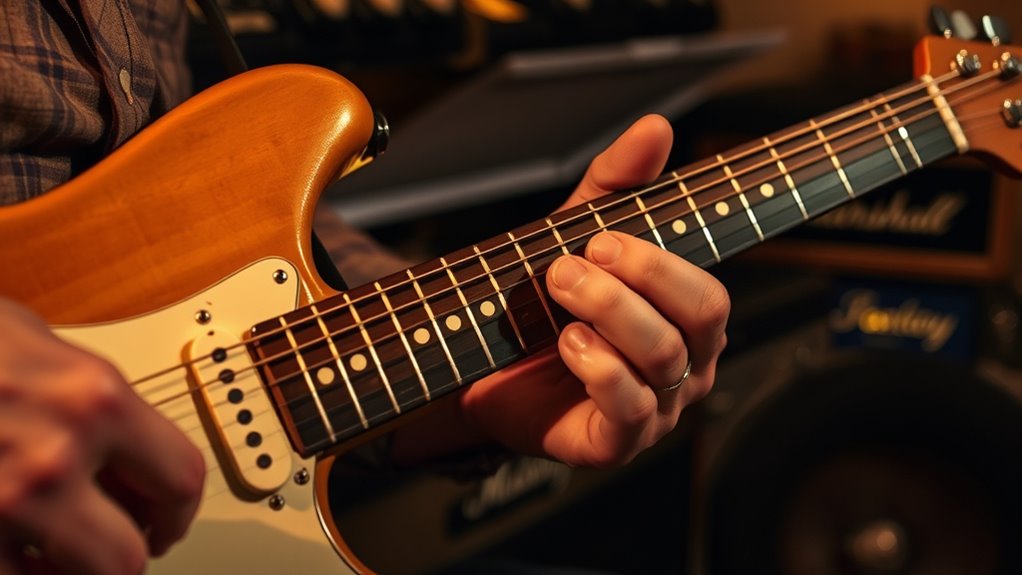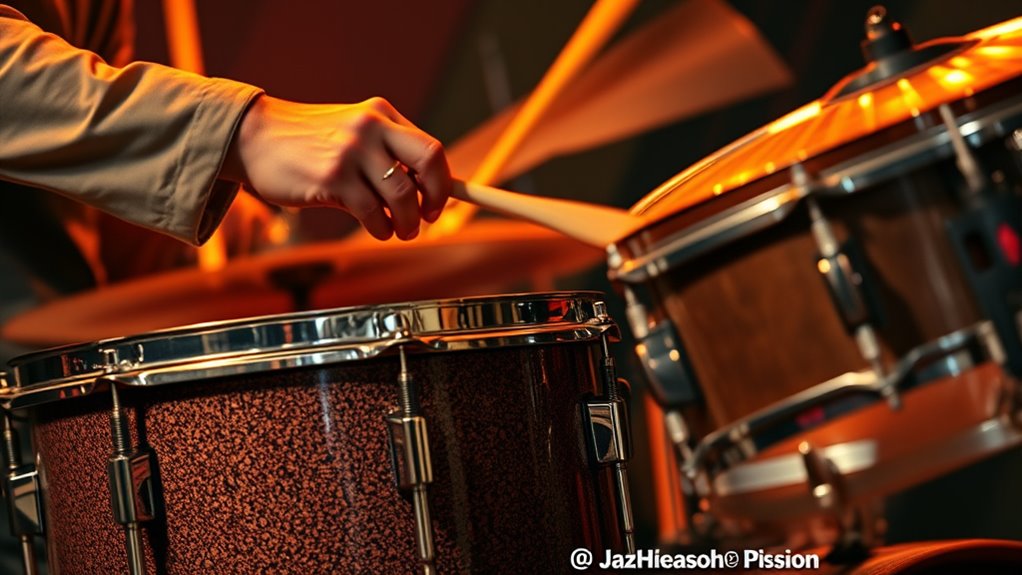To create instant soulful grooves with the Dorian mode, emphasize the sixth note to add a jazzy edge and use chromatic passing tones for smooth, expressive melodies. Incorporate classic riffs, bluesy bends, and vibrato to evoke emotion. Experiment with modal borrowing—blending modes like Phrygian or Mixolydian—to add depth. Focus on rhythmic variation and soulful phrasing. Keep exploring these techniques, and you’ll release even more powerful ways to bring the mode to life.
Key Takeaways
- Emphasize the sixth scale degree (B in D Dorian) with dynamics and embellishments for a soulful, jazzy feel.
- Incorporate chromatic passing tones and slides to create smooth, expressive melodic lines.
- Borrow notes and chords from modes like Phrygian or Mixolydian to add emotional depth and modal color.
- Use classic Dorian riffs highlighting flattened third and seventh for authentic soulful grooves.
- Apply bends and vibrato around key notes to evoke heartfelt, bluesy expression.
Emphasize the Sixth Degree for a Jazzy Feel

To achieve a jazzy feel in Dorian mode, emphasizing the sixth degree is key. This note gives Dorian its signature smooth, soulful sound. When you play a melody or solo, highlight the sixth scale degree—so, in D Dorian, focus on B. Play it slightly louder or hold it longer to draw attention. This small shift transforms the mood from minor to a more complex, jazz-inflected tonality. You can also emphasize it rhythmically, using syncopation or unexpected accents. Incorporate slides or bends into the sixth note if you’re on a stringed instrument. By making the sixth degree stand out, you evoke that classic jazz vibe, adding depth and character to your improvisation or composition. It’s a simple tweak with a powerful effect. Additionally, exploring musical modes and their characteristics can inspire new ways to approach your improvisation, blending modern influences with classic jazz nuances. Understanding scale degrees helps you target specific notes for expressive playing, making your solos more dynamic and engaging.
Incorporate Chromatic Passing Tones

Adding chromatic passing tones creates smooth shifts between notes, making your melodies more fluid. You can also use colorful note embellishments to add interest and expressiveness. When you connect chords with thoughtful voice leading, your lines sound more intentional and emotionally compelling. Incorporating automation technology into your songwriting process can help you experiment with different melodic ideas more efficiently. Additionally, understanding the offensive security measures involved in ethical hacking can inspire more dynamic and secure musical compositions. Being aware of store hours and their variations can also influence your planning for live performances or recording sessions, ensuring you maximize your creative time. Regularly applying eye patches can help maintain the hydration and nourishment of your skin, supporting your overall aesthetic goals.
Smooth Chromatic Transitions
Chromatic passing tones are essential tools for creating smooth progressions between diatonic notes in the Dorian mode. They help bridge gaps and add a subtle color to your melodies, making passages feel effortless. To implement this, slide a note half-step above or below a diatonic tone, then resolve to the target note. For example, if you’re moving from E to F in D Dorian, you can insert an E♭ as a passing tone, giving a smooth chromatic glide. Use these tones sparingly so they enhance the groove without cluttering it. Practice connecting notes like G to A or C to D with chromatic passing tones to develop a seamless, soulful feel. Incorporating musical context ensures your transitions stay engaging and expressive. Additionally, understanding musical modes can help you craft more authentic and dynamic grooves that resonate deeply with listeners. Exploring scale degrees further can provide a foundation for improvising more varied and interesting chromatic approaches.
Colorful Note Embellishments
Incorporating chromatic passing tones as embellishments can vividly enhance the color and expressiveness of your Dorian melodies. These notes add a subtle tension and release, making your phrases more vibrant. To effectively use chromatic passing tones, consider these approaches:
- Connect diatonic notes smoothly by inserting one or two chromatic notes between them, creating a fluid, soulful feel.
- Use chromatic tones to highlight melodic peaks or important notes, drawing attention and adding emotional depth.
- Keep embellishments tasteful—avoid overdoing it—to maintain clarity and avoid cluttering your groove.
- Understanding musical modes can help you craft more authentic and engaging chromatic embellishments, especially within the Dorian mode.
- Incorporating sound vibrations and their influence on musical expression can inspire more dynamic and resonant melodic choices.
- Exploring the harmonic context of your melodies can further refine how chromatic passing tones interact with underlying chords, enriching your groove.
- Awareness of musical terminology can provide a clearer framework for experimenting with chromatic embellishments and expanding your melodic vocabulary.
Expressive Voice Leading
Have you ever noticed how smooth voice leading can make a melody feel more connected and expressive? By incorporating chromatic passing tones, you add subtle tension and release that heighten emotional impact. Move smoothly between notes, even if it means stepping outside the diatonic scale briefly. For example, glide chromatically between scale degrees to create a seamless flow or emphasize a particular note. This technique helps your melodies sound more soulful and alive, especially in the Dorian mode, where the minor quality is enriched by these chromatic nuances. Practice connecting chord tones with passing tones, using half steps to bridge gaps. These small, deliberate chromatic movements make your melodies more dynamic, giving your grooves an instantly expressive, soulful character. Incorporating awareness of musical modes can further enhance the emotional depth of your improvisation. Additionally, exploring different voice leading techniques can provide new avenues for emotional expression and complexity in your improvisations. Considering the use of colorful scales can help you craft more vivid and emotionally resonant melodies.
Use Classic Dorian Riffs and Phrases

To infuse your playing with the authentic sound of the Dorian mode, focus on mastering classic riffs and phrases that define its character. These familiar motifs immediately evoke that soulful, jazzy vibe. Start by internalizing well-known Dorian licks, which often emphasize the flattened third and seventh degrees. Incorporate these into your solos to give them a genuine Dorian flavor.
Master classic Dorian riffs to capture its soulful, jazzy sound.
Here are three key ideas:
- Practice iconic riffs from jazz and blues that highlight the mode’s distinctive intervals.
- Use call-and-response phrases to create conversational, soulful lines.
- Incorporate chromatic passing notes to add richness and tension.
Experiment With Modal Interchange

Try borrowing chords from other modes to add unexpected color to your progressions. You can also mix major and minor sounds to create tension and release. Experimenting with modal borrowing lets you craft unique melodies that stand out.
Borrow From Other Modes
Experimenting with modal interchange allows you to add unexpected color and emotional depth to your Dorian melodies. Borrowing notes or chords from other modes creates surprising shifts that catch the ear and deepen your groove. For example, you can incorporate elements from the Phrygian or Mixolydian modes to evoke different moods. To do this effectively:
- Identify the distinctive notes of the mode you’re borrowing from.
- Introduce those notes gradually into your Dorian phrases.
- Use modal interchange sparingly to maintain coherence while adding flavor.
Mix Major and Minor
Blending major and minor elements within your Dorian melodies opens up new expressive possibilities. By subtly incorporating major chords or notes, you add brightness and a sense of lift, contrasting with the minor’s soulful depth. For example, try shifting from a minor Dorian tonic to a major IV chord or emphasize the major sixth interval, which Dorian naturally contains. This contrast creates a dynamic, emotionally rich sound that feels both familiar and surprising. You can also emphasize the major sixth degree in melodies to evoke a brighter, more optimistic mood. Experiment with switching between minor and major modes within a single phrase to add tension and release. This approach reveal a new palette of colors, making your grooves feel more vibrant, soulful, and instantly enthralling.
Use Modal Borrowing
Have you considered borrowing chords and notes from related modes to add unexpected color to your Dorian melodies? Modal borrowing, or modal interchange, lets you spice up your progressions by incorporating elements from parallel modes. This technique creates fresh textures and emotional depth. For example, you might swap out a typical Dorian chord with one from the Phrygian or Mixolydian mode. Here’s how to do it effectively:
- Identify chords in related modes that share common tones with Dorian.
- Insert borrowed chords during key moments for color.
- Use notes from these modes as passing tones or accents in your melodies.
Experimenting with modal interchange broadens your harmonic palette, making your grooves more soulful and dynamic.
Add Bluesy Bends and Vibrato

Adding bluesy bends and vibrato to your Dorian mode playing instantly injects emotion and expressiveness into your sound. Use bends to pitch-shift notes slightly upward, mimicking vocal inflections and adding a soulful feel. Focus on bent notes around the third, fifth, and seventh degrees—these are key to creating that bluesy vibe. Vibrato, achieved by rapidly oscillating your finger on the string, adds a shimmering, dynamic quality. Practice slow, controlled bends and vibrato until they feel natural. Incorporate these techniques into your licks and melodies to evoke a heartfelt, gritty tone. Remember, subtlety is key—overdoing bends or vibrato can feel forced. With consistent practice, these expressive tools will become second nature, instantly enriching your Dorian grooves with soulful depth.
Layer Dorian With Other Modes for Depth

To deepen your Dorian sound, try layering it with elements from other modes to create richer, more complex melodies. Combining Dorian with modes like Phrygian or Mixolydian adds color and emotional depth. You can achieve this by borrowing characteristic notes or emphasizing shared tones. Here are three ways to do it:
- Integrate the lowered second from Phrygian for a darker, exotic feel.
- Use the dominant seventh from Mixolydian to add a bluesy, relaxed groove.
- Blend in the major sixth from Ionian to brighten the overall sound and create contrast.
Focus on Rhythmic Variations and Syncopation

Focusing on rhythmic variations and syncopation reveals new expressive possibilities within the Dorian mode. By shifting your emphasis onto off-beats and unexpected accents, you breathe life into your grooves. Experiment with syncopated rhythms like dotted notes, rests, and irregular accents to create a compelling groove that surprises the listener. Incorporate rhythmic displacement, where you shift familiar patterns slightly off-beat, adding a fresh feel. Use rests strategically to give your phrases space and emphasize syncopation. Vary your rhythmic patterns from measure to measure, avoiding predictability. These techniques help you develop a more dynamic, soulful groove that resonates emotionally. Rhythmic variation and syncopation are essential tools to *liberate* the full expressive potential of the Dorian mode in your playing.
Practice With Soulful Melodic Phrasing

Building on your rhythmic explorations, developing soulful melodic phrasing enhances the emotional depth of your Dorian mode improvisations. To achieve this, focus on shaping your melodies with intention and feeling. Experiment with:
- Phrasing Lengths – Vary your note groupings to create natural, conversational lines that breathe.
- Dynamic Expression – Use volume shifts and accents to highlight emotional moments.
- Targeted Note Emphasis – Emphasize characteristic Dorian notes, like the sixth scale degree, for a distinctive, soulful sound.
Practice slowly, listening closely to how each phrase flows, and aim for clarity and expressiveness. Over time, this focused approach will help your melodies sound more heartfelt and authentic, elevating your Dorian improvisations to new soulful heights.
Frequently Asked Questions
How Can I Incorporate Dorian Mode Into Different Musical Genres?
You can incorporate Dorian mode into different genres by focusing on its unique sound—minor with a raised sixth. In jazz, use it for improvisation, blending it with modal concepts. For funk and soul, emphasize the groove and add Dorian-inflected riffs. In pop, experiment with melodies based on Dorian scales for a fresh, soulful twist. Adapt the mode’s characteristic sound to fit your genre, creating versatile and compelling music.
What Are Common Mistakes to Avoid When Improvising With Dorian?
When improvising with Dorian, avoid overusing the scale without considering its unique sound. Don’t neglect the importance of phrasing or get stuck on one note, which can make your solos sound monotonous. Steer clear of ignoring chord tones or missing the modal flavor. Instead, focus on blending scales with melodic ideas, and make sure you listen actively to the harmony to stay musically expressive and authentic.
How Does Dorian Mode Differ From Other Minor Modes?
Think of the Dorian mode as a cool breeze in a stormy night. Unlike other minor modes, Dorian has a natural sixth that adds a soulful, jazzy flavor, giving your melodies more life. It’s like a minor mode with a twist—bright yet moody. While natural minor and Aeolian lack this sixth, Dorian’s unique sound makes it perfect for creating grooves that feel both grounded and lively.
What Instruments Are Best Suited for Exploring Dorian Grooves?
When exploring Dorian grooves, you should choose instruments that can bring out its soulful, jazzy feel. Think electric guitars, bass, and keyboards, as they can easily craft smooth, melodic lines. Horns like saxophones and trumpets add a jazzy touch, while drums with a relaxed groove emphasize the mode’s laid-back vibe. Focus on instruments that allow expressive phrasing, helping you create compelling, groove-oriented melodies in Dorian.
Can Dorian Mode Be Used Effectively in Solo Compositions?
You can absolutely use Dorian mode effectively in solo compositions—it’s like having a secret weapon in your musical arsenal. Its unique blend of minor and major qualities creates a soulful, expressive sound that captivates listeners. When you craft solos with Dorian, you add a vibrant, improvisational energy that makes your music stand out. So, don’t hesitate—embrace Dorian for your solos and watch your compositions come alive with fresh, compelling character.
Conclusion
By mastering these Dorian mode hacks, you’ll open a soulful groove that can electrify any jam session. Embrace the jazzy sixth, add chromatic flair, and layer modes for richness. With rhythmic twists and soulful phrasing, you’ll create melodies that resonate deep within listeners’ hearts—like an unstoppable wave of emotion crashing over the soul. Keep experimenting, and soon you’ll be crafting grooves so infectious, they’ll echo through eternity.









